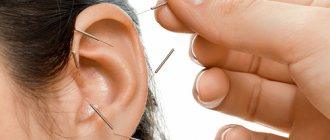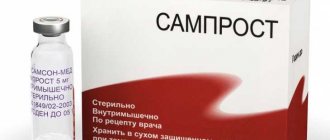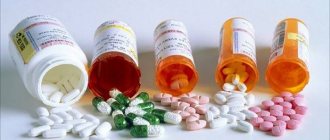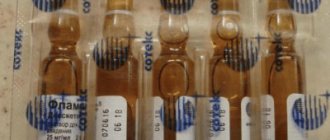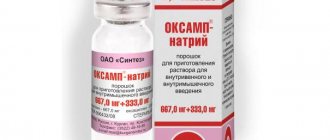Axamon belongs to the pharmacological group of cholinesterase inhibitors, intended for the treatment of diseases of the nervous system. Axamon activates the transmission of neuromuscular impulses, improves the conduction of excitation through smooth muscle cells and nerves. It also enhances the effect of serotonin, histamine, oxytocin, acetylcholine on smooth muscles. The use of Axamon helps restore the peripheral nervous system, which has been damaged by the use of antibiotics, local antiseptics, toxins, inflammation or injury. The drug tones the muscles of internal organs, reduces heart rate, increases salivation, improves memory, and stimulates the central nervous system. Axamon is often used by students and schoolchildren, as it improves concentration and helps cope with mental stress.
pharmachologic effect
Axamon® is a reversible cholinesterase inhibitor that directly stimulates impulse conduction at the neuromuscular synapse and in the central nervous system (CNS) due to blockade of membrane potassium channels.
It enhances the effect on smooth muscles of not only acetylcholine, but also adrenaline, serotonin, histamine and oxytocin. Aksamon® has the following pharmacological effects:
— Improves and stimulates impulse conduction in the nervous system and neuromuscular transmission;
— Improves conductivity in the peripheral nervous system, impaired due to injury, inflammation, exposure to local anesthetics, some antibiotics, potassium chloride, etc.;
— Increases the contractility of smooth muscle organs under the influence of agonists of acetylcholine, adrenaline, serotonin, histamine and oxytocin receptors, with the exception of potassium chloride;
— Improves memory, inhibits the progressive development of dementia.
Does not have teratogenic, embryotoxic, mutagenic, carcinogenic or immunotoxic effects. Does not affect the endocrine system.
special instructions
When treating with Axamon, a possible increase in uterine tone should be taken into account. Studies have shown that side effects occur extremely rarely, occurring in approximately 6.5% of cases. As a rule, they are mild and do not require discontinuation of the drug. Axamon should be carefully combined with other drugs. Thus, simultaneous use with cholinergic drugs increases the risk of a cholinergic crisis in patients with myasthenia gravis. Axamon weakens the effect of potassium chloride, local antiseptics and antibiotics. When used together with beta-blockers, the likelihood of developing bradycardia increases. Axamon increases the potency of m-cholinomimetics and drugs that depress the central nervous system.
Pharmacokinetics
When administered subcutaneously and intramuscularly, it is quickly absorbed. The maximum concentration in the blood is achieved 25-30 minutes after administration. Binding to blood plasma proteins is 40-50%. The drug quickly enters the tissues. Metabolized in the liver. The drug is excreted through the kidneys (mainly by tubular secretion and only 1/3 by glomerular filtration) and extrarenally (through the gastrointestinal tract). The half-life of Axamon® when administered parenterally is 2-3 hours. After parenteral administration, 34.8% of the drug dose is excreted unchanged in the urine.
Pharmacological properties
Aksamon is part of the group of cholinesterase inhibitors and is actively used in the treatment of nervous pathologies.
The range of actions of the medication includes the following.
- As a reversible cholinesterase inhibitor (a substance that reduces enzyme activity), the drug stimulates the passage of electrical impulses at the neuromuscular junction, a major part of the nervous system, by blocking membrane ion channels.
- The compound makes the effect on smooth muscles of acetylcholine, adrenaline, 5-hydroxytryptamine, histamine, oxytocin, in addition to potassium chloride, stronger.
- The active substance improves conductivity in the peripheral system, disturbed by inflammation, long-term use of potassium chloride, non-systemic anesthetics, a number of antibiotics, other drugs, injuries and other reasons.
- The medicine improves memory and slows down dementia processes such as deterioration in thinking, memory, and behavioral disorders.
The drug does not have a negative effect on the embryo and fetus, does not increase the risk of tumor malignancy, and does not change the composition of cells and the functionality of the endocrine system.
After injection (intra muscle or under the skin), the solution begins to be absorbed immediately. The maximum plasma concentration is observed after half an hour. The active substance is half bound to plasma proteins and quickly distributed throughout the tissues. Metabolization occurs in the liver. The kidneys (only a third by the glomerular filtration mechanism, the rest by calcium secretion) and the intestines are responsible for excretion. The half-life is approximately two and a half hours. When the compound is injected into the body by injection, a third is excreted in its original form.
Contraindications
— Epilepsy
— Extrapyramidal disorders with hyperkinesis;
- Angina pectoris;
- Severe bradycardia;
- Bronchial asthma;
— Mechanical obstruction of the intestine or urinary tract;
— Vestibular disorders;
— Peptic ulcer of the stomach or duodenum in the acute stage;
- Children under 18 years of age (there is no systematic data on use in children);
- Hypersensitivity to any of the components of the drug.
Prescribed with caution for gastric and duodenal ulcers, thyrotoxicosis, diseases of the cardiovascular system, a history of obstructive diseases of the respiratory system or acute respiratory diseases.
Side effects
The frequency of adverse reactions that may occur during use of the drug is given in the following classification: very common (>1/10 prescriptions), frequent (1/10-1/100 prescriptions), infrequent (1/100-1/1000 prescriptions), rare (1/1000-1/10,000 prescriptions), very rare (<1/10,000 prescriptions) and unknown frequency (frequency cannot be calculated from available data).
From the mental side: infrequent - drowsiness.
From the nervous system: infrequently - dizziness, headache, convulsions; unknown frequency - tremor.
From the organ of vision: unknown frequency - miosis.
From the side of the heart: frequent - palpitations, bradycardia; unknown frequency - chest pain.
From the respiratory system: infrequent - increased secretion of bronchial secretions.
From the gastrointestinal tract: frequent - drooling, nausea; infrequently - vomiting; rare - diarrhea, epigastric pain.
From the liver and biliary tract: unknown frequency - jaundice.
From the skin and subcutaneous tissues: infrequently - itching, rash.
General disorders and disorders at the injection site: frequent - increased sweating; infrequent - general weakness; unknown frequency - hypothermia.
Salivation and bradycardia can be reduced with m-anticholinergic drugs (including atropine, cyclodol, metacin).
If itching or rash occurs, stop taking the drug. In other cases, reduce the dose or interrupt the drug for a short time (for 1-2 days).
Directions for use and doses
The drug is administered subcutaneously or intramuscularly. Doses and duration of treatment are determined individually depending on the severity of the disease.
Diseases of the peripheral nervous system
Mono- and polyneuropathies of various origins, polyradiculopathy: subcutaneously or intramuscularly 5-15 mg 1-2 times a day, course 10-15 days (in severe cases - up to 30 days); then treatment is continued with the tablet form of the drug.
Myasthenia and myasthenic syndrome: subcutaneously or intramuscularly 15-30 mg 1-3 times a day with further transition to the tablet form. The general course of treatment is 1-2 months. If necessary, treatment can be repeated several times with a break between courses of 1-2 months.
CNS diseases:
Bulbar paralysis and paresis: subcutaneously or intramuscularly 5-15 mg 1-2 times a day, course 10-15 days; further, if possible, switch to tablet form;
Recovery period of organic lesions of the central nervous system, accompanied by motor disorders: IM 10-15 mg 1-2 times a day, course up to 15 days; further, if possible, switch to tablet form.
Treatment and prevention of intestinal atony: initial dose - 10-15 mg 1-2 times a day for 1-2 weeks.
Compound
An injection solution called Aksamon is a colorless and odorless liquid, poured into ampoules.
The active component is ipidacrine hydrochloride monohydrate. Additional substances – liquid for injection, hydrochloric acid (dissolved). Axamon, bottled in ampoules, may differ in the concentration of ipidacrine. Pharmacies today offer two options - 5 and 15 milligrams per milliliter. Ampoules are packaged in 10 pieces.
In addition to ampoules with solution, the drug is produced in the form of tablets.
Overdose
Symptoms: decreased appetite, bronchospasm, lacrimation, increased sweating, constriction of the pupils, nystagmus, increased gastrointestinal peristalsis, spontaneous bowel movements and urination, vomiting, jaundice, bradycardia, intracardiac conduction disturbances, arrhythmias, decreased blood pressure, restlessness, anxiety, agitation, feelings of fear, ataxia, convulsions, coma, speech disorders, drowsiness and general weakness.
Treatment: use of m-anticholinergic drugs (including atropine, cyclodol, metacin), symptomatic therapy.
Reviews about the pharmacy Europharm
Rated 4 based on 50 reviews.
Review of Europharm pharmacy
Leave your review about our pharmacy
Not all fields are filled in
Diana 07/15/2019
Thanks to the online pharmacy, I no longer run around the city looking for the medications I need!
I was able to buy the same Retasol, Fleming ointment, etc. without any problems. drugs that you usually can’t find during the day. I pre-order and pick it up in 3 days. The site itself is convenient, there were no problems with registration. I liked that you can click on the “diseases” tab and immediately select an affordable remedy for a specific disease. Andrey 07/17/2019
Our child was prescribed a course of growth hormone.
We tried several pharmacies, and my son’s tests always didn’t change much. Finally, God gave me the chance to buy Ginotropin from you, you can’t even imagine what progress in growth we have seen over the past 3 months, and all because, unlike others, you store and transport it in refrigerated containers. Of course, we began to buy from you not only this, but also other medicines. When a pharmacy treats drugs that are difficult to store responsibly and does not skimp on this, then such a company can be trusted. P\S Thank you! Alexander 10.15.2019
First, I want to say a few words about the staff: very attentive, patient and competent people (they listened, advised, helped... I really liked it!) The second thing I liked is that there is a choice, cheaper, more expensive, there are analogues... They can select drugs for every client.
And it’s important that you can buy the entire list of medications in one place, without straining yourself by remembering what you bought and what else you need. I will use this gift of civilization, which I advise you to do. Nina 05/28/2020
I agree.
Very attentive and pleasant people work here - both on telephones and as couriers. Thank you! Diana 08/01/2020
Thank you. You are a pharmacy whose prices are noticeably lower. 4 pharmacies have sorted out the right price for mizo drops from you.
Analogs
Finding a cure is not as easy as it seems. Some patients need Axamon therapy, but cannot always use it due to negative reactions.
The most common analogues of the drug are:
- Neuromidin;
- Amiridine;
- Ipidacrine.
It is worth noting that the drug Aksamon is produced in Russia, among its analogues it is the cheapest, but this does not mean that it is the most ineffective. The average price in pharmacies is about one thousand rubles, but you can find cheaper ones.
Patients treated with Axamon noted that the drug helped them feel better. Quite rarely, patients complained of side effects, among which the most common were insomnia and nausea. However, it is important to remember that self-medication is very dangerous to health. Despite positive reviews and recommendations from friends, first of all, you need to see a doctor who, after an examination and diagnosis, will prescribe treatment with a specific drug.
